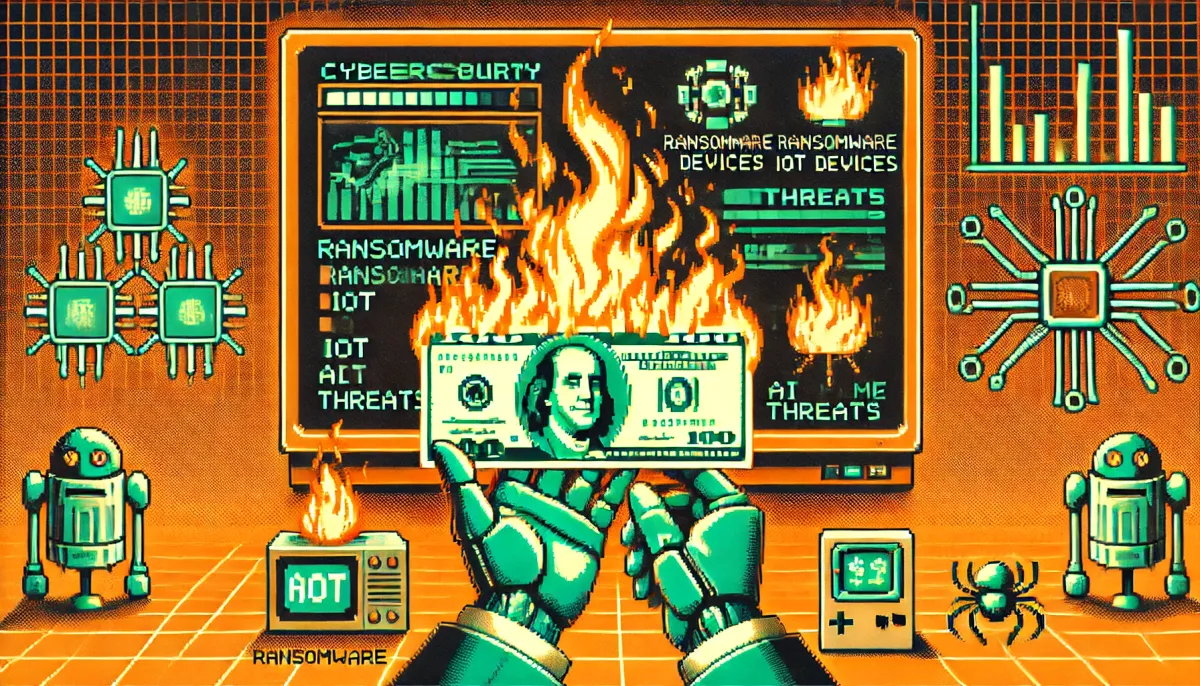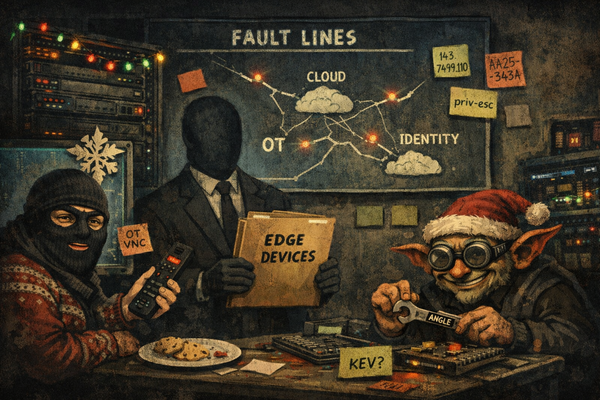Strategic Prioritization of Cybersecurity Threats for 2025: Ransomware, IoT Vulnerabilities, and AI-Powered Attacks
AI-powered attacks represent another formidable threat, as cybercriminals leverage AI and machine learning technologies to automate and scale their operations...

Research Summary
As we approach 2025, the cybersecurity landscape is poised for significant challenges, with threat intelligence directors needing to prioritize their focus on three primary threats: the evolution of ransomware, vulnerabilities in the Internet of Things (IoT), and the increasing sophistication of artificial intelligence (AI)-powered attacks. These threats are not only evolving in complexity but also in their potential impact on organizational operations, data security, and reputational integrity. Understanding these threats and implementing effective mitigation strategies is crucial for organizations aiming to safeguard their assets and maintain operational resilience.
Ransomware continues to evolve, with attackers employing more sophisticated tactics such as double extortion, where data is both encrypted and threatened to be released publicly unless a ransom is paid. The rise of Ransomware-as-a-Service (RaaS) further exacerbates this threat by enabling even less skilled cybercriminals to launch attacks, posing significant financial and operational risks across all sectors. Meanwhile, the rapid proliferation of IoT devices introduces numerous security gaps, as many lack robust security features, making them prime targets for attackers seeking entry points into networks. This can lead to unauthorized access, data theft, and even control over critical infrastructure systems.
AI-powered attacks represent another formidable threat, as cybercriminals leverage AI and machine learning technologies to automate and scale their operations. This includes crafting more convincing phishing emails and rapidly identifying vulnerabilities, which increases the success rate of cyber attacks and makes them harder to detect and mitigate. Organizations must adopt a proactive cybersecurity posture, incorporating advanced threat detection systems, regular software updates, and comprehensive employee training to counter these sophisticated threats.
To effectively address these challenges, organizations should focus on securing IoT devices, enhancing cloud security, and leveraging AI for threat detection and response. By staying ahead of these evolving risks, businesses can better protect their data, maintain customer trust, and ensure compliance with regulatory requirements. Implementing robust security measures and fostering a culture of cybersecurity awareness will be key to navigating the complex threat landscape of 2025.
Findings
-
Ransomware Evolution and Ransomware-as-a-Service (RaaS): Ransomware attacks are becoming more sophisticated, with attackers using double extortion tactics to encrypt data and threaten to release it publicly if ransoms are not paid. The rise of RaaS models allows even less skilled cybercriminals to launch attacks by leasing ransomware tools from developers. This evolution poses significant financial and operational risks to organizations across all sectors. (Source: The Beckage Firm)
-
Internet of Things (IoT) Vulnerabilities: The rapid expansion of IoT devices introduces numerous security gaps, as many of these devices lack robust security features. This makes them easy targets for attackers seeking entry points into networks, leading to unauthorized access, data theft, and control over critical infrastructure systems. (Source: Morefield)
-
AI-Powered Attacks: AI and machine learning technologies are being used by attackers to automate and scale attacks, craft more convincing phishing emails, and identify vulnerabilities rapidly. This increases the success rate of cyber attacks and makes them harder to detect and mitigate. (Source: Systemagic)
-
Supply Chain Attacks: Cybercriminals are targeting vulnerabilities in third-party vendors and suppliers to infiltrate larger organizations. By compromising software updates or hardware components, attackers can gain widespread access, leading to data breaches and unauthorized access to sensitive systems. (Source: Cloud Security Alliance)
-
Cloud Security Threats: As organizations migrate to cloud services, misconfigurations, insecure APIs, and inadequate access controls become prevalent issues. Attackers exploit these weaknesses to access sensitive data stored in the cloud, leading to data breaches and loss of customer trust. (Source: The Beckage Firm)
Breaches and Case Studies
-
Arup Deepfake Scam - 2024 - Systemagic:
- Description: UK engineering firm Arup fell victim to a deepfake scam, costing them £20 million. Attackers used AI to create realistic fake videos to impersonate company executives and authorize fraudulent transactions.
- Actionable Takeaways: Implement multi-factor authentication for financial transactions, train employees to verify unusual requests, and establish verification protocols for sensitive actions.
-
SolarWinds Supply Chain Attack - 2020 - The Beckage Firm:
- Description: Attackers compromised SolarWinds' software updates, gaining access to numerous government and private sector organizations. This attack highlighted the vulnerabilities in supply chain security.
- Actionable Takeaways: Conduct thorough security assessments of third-party vendors, implement strict access controls, and monitor software updates for anomalies.
Forecast
Short-Term Forecast (3-6 months)
-
Increased Ransomware Activity with New Variants
- Ransomware attacks will continue to rise, with new groups like RansomHub and Meow gaining momentum. These groups have shown significant increases in activity, with RansomHub seeing a 57.78% increase in victims and Meow surging by 375% in recent months. This trend indicates a growing threat landscape where new ransomware variants are rapidly emerging and targeting organizations across various sectors.
- References: CYFIRMA
-
Exploitation of IoT Vulnerabilities
- The rapid expansion of IoT devices will lead to increased exploitation of vulnerabilities in these devices. Many IoT devices lack robust security features, making them easy targets for attackers. This will result in unauthorized access and potential control over critical infrastructure systems, posing significant risks to organizations.
- References: Morefield
Long-Term Forecast (12-24 months)
-
Proliferation of AI-Powered Cyber Attacks
- AI and machine learning technologies will be increasingly used by cybercriminals to automate and scale attacks. This will include crafting more convincing phishing emails and rapidly identifying vulnerabilities, making attacks more successful and harder to detect. Organizations will need to enhance their AI capabilities for threat detection and response to counter these sophisticated attacks.
- References: Systemagic
-
Increased Focus on Supply Chain Security
- Supply chain attacks will become more prevalent as cybercriminals target vulnerabilities in third-party vendors and suppliers. This will lead to widespread access to larger organizations, resulting in data breaches and unauthorized access to sensitive systems. Organizations will need to implement strict security protocols and conduct regular security assessments of their supply chains.
- References: Cloud Security Alliance
Followup Research
- What are the most effective strategies for securing IoT devices against emerging threats in 2025?
- How can organizations leverage AI to enhance their cybersecurity posture and detect AI-powered attacks?
- What are the best practices for mitigating supply chain vulnerabilities in a rapidly evolving threat landscape?
- How can businesses balance the benefits of cloud adoption with the need for robust security measures?
Recommendations, Actions and Next Steps
-
Implement Advanced Threat Detection Systems: Deploy AI-powered threat detection tools to identify and respond to sophisticated attacks in real-time. This includes monitoring for unusual network activity and automating incident response processes.
-
Enhance IoT Security: Regularly update IoT devices with the latest security patches, change default passwords, and segment IoT networks from critical business systems to minimize the impact of potential breaches.
-
Strengthen Cloud Security: Conduct regular security audits of cloud configurations, secure APIs, and implement robust access controls to protect sensitive data stored in the cloud.
-
Conduct Employee Training: Provide comprehensive cybersecurity training to employees, focusing on recognizing phishing attempts, verifying unusual requests, and understanding the risks associated with AI-powered attacks.
-
Secure Supply Chains: Implement strict security protocols for third-party vendors, conduct regular security assessments, and monitor supply chain interactions for potential vulnerabilities.
APPENDIX
References and Citations
- The Beckage Firm - Top 10 Emerging Threats in 2025
- Morefield - 5 Cybersecurity Predictions for 2025
- Systemagic - Top 5 Cybersecurity Threats to Be Aware Of In 2025
- Cloud Security Alliance - Cybersecurity Risk Mitigation Recommendations for 2024-2025
Mitre ATTACK TTPs
- T1190 - Exploit Public-Facing Application
- T1078 - Valid Accounts
- T1566 - Phishing
- T1486 - Data Encrypted for Impact
- T1203 - Exploitation for Client Execution
Mitre ATTACK Mitigations
- M1049 - Antivirus/Antimalware
- M1050 - Exploit Protection
- M1026 - Privileged Account Management
- M1017 - User Training
- M1030 - Network Segmentation
AlphaHunt
Get questions like this? Does it take a chunks out of your day? Would you rather be working on more interesting intelligence tasks? Would you like help with the research?
This baseline report was thoughtfully researched and took 5 minutes.. It's meant to be a rough draft for you to enhance with the unique insights that make you an invaluable analyst. We just did the grunt work..
Did this help you? Forward it to a friend!
(c) 2024 CSIRT Gadgets, LLC
License - CC BY-SA 4.0



![[DEEP RESEARCH] Zero-Days Are a Distraction: 2025’s Biggest Losses Were Stolen Tokens + OAuth](/content/images/size/w600/2025/12/zz-3.png)

